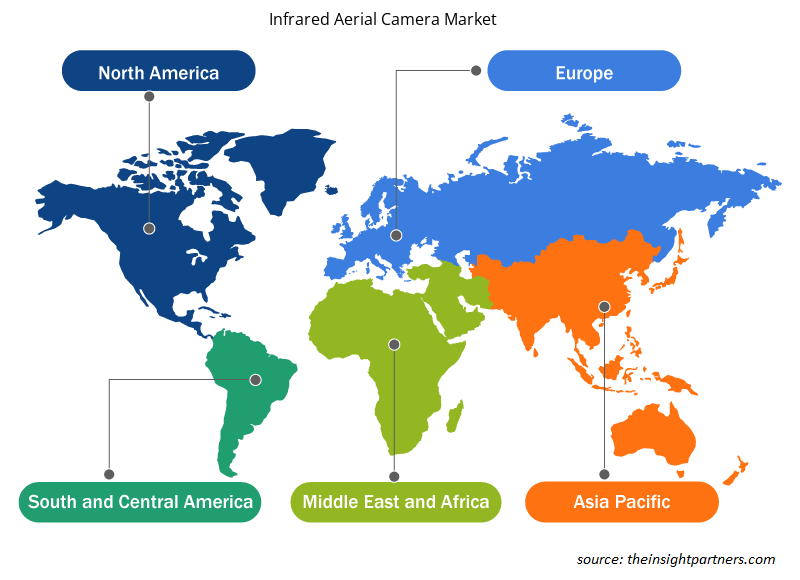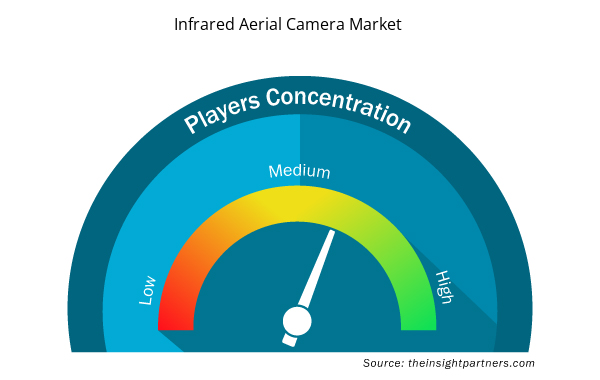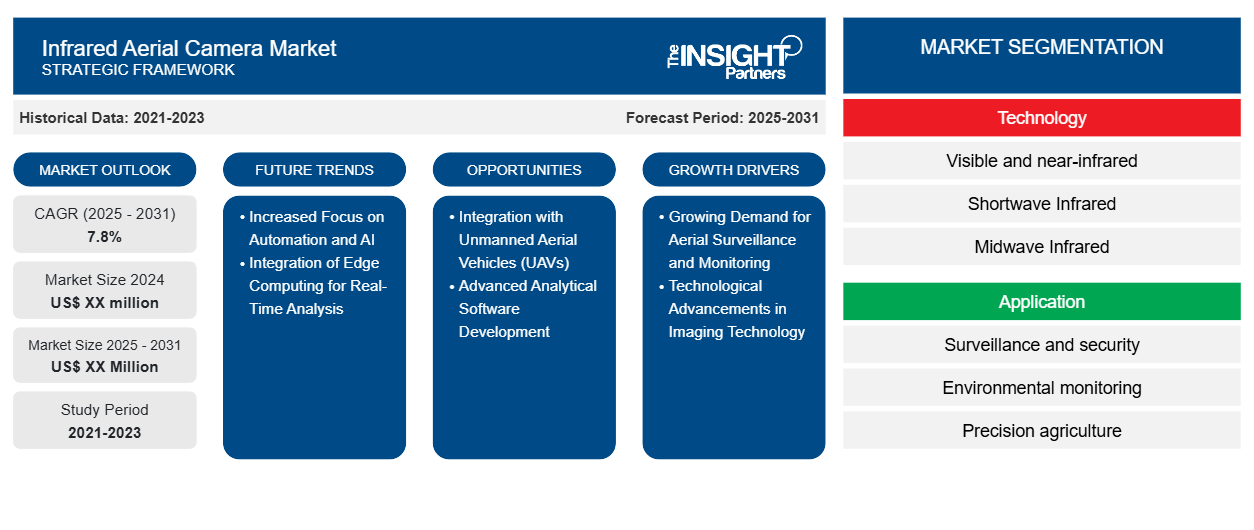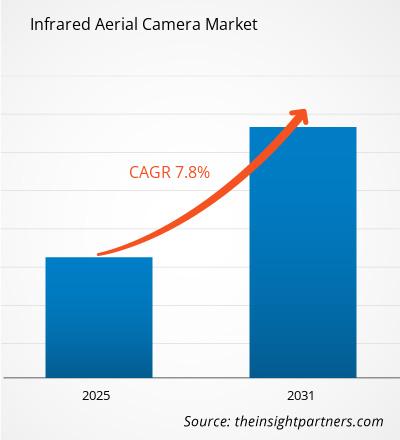Si prevede che il mercato delle telecamere aeree a infrarossi registrerà un CAGR del 7,8% dal 2023 al 2031, con una dimensione di mercato in espansione da XX milioni di dollari nel 2023 a XX milioni di dollari entro il 2031.
Il rapporto è segmentato per tecnologia (visibile e vicino infrarosso ( VNIR ), infrarosso a onde corte ( SWIR ), infrarosso a onde medie ( MWIR ), infrarosso a onde lunghe ( LWIR )); applicazione (sorveglianza e sicurezza, monitoraggio ambientale, agricoltura di precisione, ispezione delle infrastrutture); geografia (Nord America, Europa, Asia-Pacifico, Medio Oriente e Africa, Sud e Centro America).
L'analisi globale è ulteriormente suddivisa a livello regionale e nei principali paesi. Il rapporto offre il valore in USD per l'analisi e i segmenti di cui sopra
Scopo del rapporto
Il report Infrared Aerial Camera Market di The Insight Partners mira a descrivere il panorama attuale e la crescita futura, i principali fattori trainanti, le sfide e le opportunità. Ciò fornirà spunti a vari stakeholder aziendali, come:
- Fornitori/produttori di tecnologia: per comprendere le dinamiche di mercato in evoluzione e conoscere le potenziali opportunità di crescita, consentendo loro di prendere decisioni strategiche informate.
- Investitori: condurre un'analisi completa delle tendenze in merito al tasso di crescita del mercato, alle proiezioni finanziarie del mercato e alle opportunità esistenti lungo la catena del valore.
- Enti di regolamentazione: regolamentano le politiche e le attività di controllo sul mercato allo scopo di ridurre al minimo gli abusi, preservare la fiducia degli investitori e sostenere l'integrità e la stabilità del mercato.
Segmentazione del mercato delle telecamere aeree a infrarossi
Tecnologia
- Visibile e vicino infrarosso
- Infrarossi a onde corte
- Infrarossi a onde medie
- Infrarossi a onde lunghe
Applicazione
- Sorveglianza e sicurezza
- Monitoraggio ambientale
- Agricoltura di precisione
- Ispezione delle infrastrutture
Personalizza questo report in base alle tue esigenze
Riceverai la personalizzazione gratuita di qualsiasi report, comprese parti di questo report, o analisi a livello nazionale, pacchetto dati Excel, oltre a usufruire di grandi offerte e sconti per start-up e università
- Scopri le principali tendenze di mercato in questo rapporto.Questo campione GRATUITO includerà analisi di dati che spaziano dalle tendenze di mercato alle stime e alle previsioni.
Driver di crescita del mercato delle telecamere aeree a infrarossi
- Crescente domanda di sorveglianza e monitoraggio aerei: a causa della crescente necessità di sorveglianza aerea in agricoltura, monitoraggio ambientale e messa in sicurezza di spazi urbani e rurali, il mercato delle telecamere aeree a infrarossi è fortemente motivato. Le telecamere si dimostrano cruciali nel fornire informazioni preziose sulla salute delle colture, nel rilevare incendi boschivi e nel rafforzare la sicurezza in città e paesi. Fornendo immagini termiche, le installazioni di telecamere a infrarossi possono monitorare efficacemente lo spazio in un ambiente con visibilità limitata, il che le rende essenziali in molteplici applicazioni.
- Progressi tecnologici nella tecnologia di imaging: il mercato delle telecamere aeree a infrarossi è destinato a espandersi a causa del continuo aumento dei fattori tecnologici con la tecnologia di imaging a infrarossi. Il miglioramento della sensibilità del sensore, una migliore risoluzione su un'immagine e i risultati nell'elaborazione dei dati sono tutti fattori che rendono le telecamere a infrarossi più efficienti e versatili. Quindi, con l'espansione della tecnologia, i costi delle telecamere a infrarossi continuano a diminuire, soddisfacendo sia le grandi aziende che i piccoli agricoltori.
Tendenze future del mercato delle telecamere aeree a infrarossi
- Maggiore attenzione all'automazione e all'intelligenza artificiale: c'è una maggiore attenzione all'automazione e all'intelligenza artificiale in termini di tendenze di analisi dei dati delle telecamere aeree a infrarossi. I sistemi automatizzati elaborano rapidamente immensi volumi di dati di immagini termiche, rendendo le cose visibili invisibili all'occhio umano: modelli e anomalie. Questa tendenza in via di sviluppo è particolarmente rilevante per il settore agricolo, dove l'intelligenza artificiale aiuta a ottimizzare le pratiche di gestione in base alle informazioni provenienti dai dati termici.
- Integrazione dell'edge computing per l'analisi in tempo reale: il futuro delle telecamere aeree a infrarossi vedrà una maggiore integrazione dell'edge computing, consentendo l'elaborazione dei dati in tempo reale direttamente sul dispositivo. Ciò migliorerà la velocità e l'efficienza dell'analisi delle immagini termiche, fornendo informazioni immediate per settori come agricoltura, energia e infrastrutture. Con algoritmi basati sull'intelligenza artificiale sull'edge, il processo decisionale sarà più rapido e preciso, migliorando l'efficienza operativa e la reattività.
Opportunità di mercato per le telecamere aeree a infrarossi
- Integrazione con veicoli aerei senza pilota (UAV): l'integrazione di telecamere aeree a infrarossi con UAV, o droni, è una nuova grande opportunità da sfruttare. I droni con immagini termiche consentono una scansione rapida ed efficiente di grandi aree, rendendoli particolarmente utili per applicazioni quali ricerca e soccorso, monitoraggio della fauna selvatica e ispezione delle infrastrutture. Man mano che il mercato dei droni continua a espandersi, potrebbe aumentare anche la necessità di telecamere a infrarossi compatibili, aprendo nuove strade all'innovazione e alla collaborazione.
- Sviluppo software analitico avanzato: le aziende hanno la possibilità di sviluppare software avanzato per integrare le telecamere aeree a infrarossi. I produttori possono offrire strumenti per l'analisi e la visualizzazione dei dati per migliorare il valore dei loro prodotti di imaging. Il software può facilitare una migliore interpretazione dei dati termici per migliorare la qualità del processo decisionale e dei risultati in applicazioni come l'agricoltura e il monitoraggio ambientale.
Approfondimenti regionali sul mercato delle telecamere aeree a infrarossi
Le tendenze regionali e i fattori che influenzano il mercato delle telecamere aeree a infrarossi durante il periodo di previsione sono stati ampiamente spiegati dagli analisti di Insight Partners. Questa sezione discute anche i segmenti e la geografia del mercato delle telecamere aeree a infrarossi in Nord America, Europa, Asia Pacifico, Medio Oriente e Africa e America meridionale e centrale.

- Ottieni i dati specifici regionali per il mercato delle telecamere aeree a infrarossi
Ambito del rapporto di mercato sulle telecamere aeree a infrarossi
| Attributo del report | Dettagli |
|---|---|
| Dimensioni del mercato nel 2023 | XX milioni di dollari USA |
| Dimensioni del mercato entro il 2031 | XX milioni di dollari USA |
| CAGR globale (2023-2031) | 7,8% |
| Dati storici | 2021-2022 |
| Periodo di previsione | 2024-2031 |
| Segmenti coperti | Per tecnologia
|
| Regioni e Paesi coperti | America del Nord
|
| Leader di mercato e profili aziendali chiave |
|
Densità dei player del mercato delle telecamere aeree a infrarossi: comprendere il suo impatto sulle dinamiche aziendali
Il mercato delle telecamere aeree a infrarossi sta crescendo rapidamente, spinto dalla crescente domanda degli utenti finali dovuta a fattori quali l'evoluzione delle preferenze dei consumatori, i progressi tecnologici e una maggiore consapevolezza dei vantaggi del prodotto. Con l'aumento della domanda, le aziende stanno ampliando le loro offerte, innovando per soddisfare le esigenze dei consumatori e capitalizzando sulle tendenze emergenti, il che alimenta ulteriormente la crescita del mercato.
La densità degli operatori di mercato si riferisce alla distribuzione di aziende o società che operano in un particolare mercato o settore. Indica quanti concorrenti (operatori di mercato) sono presenti in un dato spazio di mercato in relazione alle sue dimensioni o al valore di mercato totale.
Le principali aziende che operano nel mercato delle telecamere aeree a infrarossi sono:
- Tecnologie di visione alleate GmbH
- Tecnologie Axsys
- Sistemi FLIR, Inc.
- Sistemi di missione General Dynamics, Inc.
- Telecamere a infrarossi Inc.
Disclaimer : le aziende elencate sopra non sono classificate secondo un ordine particolare.

- Ottieni una panoramica dei principali attori del mercato delle telecamere aeree a infrarossi
Punti di forza chiave
- Copertura completa: il rapporto copre in modo completo l'analisi di prodotti, servizi, tipologie e utenti finali del mercato delle telecamere aeree a infrarossi, fornendo una panoramica olistica.
- Analisi degli esperti: il rapporto è compilato sulla base della conoscenza approfondita di esperti e analisti del settore.
- Informazioni aggiornate: il rapporto garantisce la pertinenza aziendale grazie alla copertura di informazioni recenti e tendenze nei dati.
- Opzioni di personalizzazione: questo report può essere personalizzato per soddisfare le esigenze specifiche del cliente e adattarsi in modo appropriato alle strategie aziendali.
Il rapporto di ricerca sul mercato delle telecamere aeree a infrarossi può, quindi, aiutare a guidare il percorso di decodifica e comprensione dello scenario del settore e delle prospettive di crescita. Sebbene possano esserci alcune preoccupazioni valide, i vantaggi complessivi di questo rapporto tendono a superare gli svantaggi.
- Analisi storica (2 anni), anno base, previsione (7 anni) con CAGR
- Analisi PEST e SWOT
- Valore/volume delle dimensioni del mercato - Globale, regionale, nazionale
- Industria e panorama competitivo
- Set di dati Excel


- Authentication and Brand Protection Market
- Cling Films Market
- Electronic Signature Software Market
- Bioremediation Technology and Services Market
- Small Molecule Drug Discovery Market
- Skin Graft Market
- Fishing Equipment Market
- Latent TB Detection Market
- Cut Flowers Market
- Battery Testing Equipment Market

Report Coverage
Revenue forecast, Company Analysis, Industry landscape, Growth factors, and Trends

Segment Covered
This text is related
to segments covered.

Regional Scope
North America, Europe, Asia Pacific, Middle East & Africa, South & Central America

Country Scope
This text is related
to country scope.
Domande frequenti
Some of the customization options available based on the request are an additional 3-5 company profiles and country-specific analysis of 3-5 countries of your choice. Customizations are to be requested/discussed before making final order confirmation# as our team would review the same and check the feasibility
The report can be delivered in PDF/PPT format; we can also share excel dataset based on the request
Increased Focus on Automation and AI is anticipated to play a significant role in the global Infrared Aerial Camera Market in the coming years
Growing Demand for Aerial Surveillance and Technological Advancements in Imaging Technology are the major factors driving the Infrared Aerial Camera Market
The Infrared Aerial Camera Market is estimated to witness a CAGR of 7.8% from 2023 to 2031
Trends and growth analysis reports related to Electronics and Semiconductor : READ MORE..
1. Allied Vision Technologies GmbH
2. Axsys Technologies
3. FLIR Systems, Inc.
4. General Dynamics Mission Systems, Inc.
5. Infrared Cameras Inc
6. InfraTec GmbH
7. Leonardo DRS, Inc.
8. Opgal
9. Teledyne DALSA
10. Xenics
The Insight Partners performs research in 4 major stages: Data Collection & Secondary Research, Primary Research, Data Analysis and Data Triangulation & Final Review.
- Data Collection and Secondary Research:
As a market research and consulting firm operating from a decade, we have published and advised several client across the globe. First step for any study will start with an assessment of currently available data and insights from existing reports. Further, historical and current market information is collected from Investor Presentations, Annual Reports, SEC Filings, etc., and other information related to company’s performance and market positioning are gathered from Paid Databases (Factiva, Hoovers, and Reuters) and various other publications available in public domain.
Several associations trade associates, technical forums, institutes, societies and organization are accessed to gain technical as well as market related insights through their publications such as research papers, blogs and press releases related to the studies are referred to get cues about the market. Further, white papers, journals, magazines, and other news articles published in last 3 years are scrutinized and analyzed to understand the current market trends.
- Primary Research:
The primarily interview analysis comprise of data obtained from industry participants interview and answers to survey questions gathered by in-house primary team.
For primary research, interviews are conducted with industry experts/CEOs/Marketing Managers/VPs/Subject Matter Experts from both demand and supply side to get a 360-degree view of the market. The primary team conducts several interviews based on the complexity of the markets to understand the various market trends and dynamics which makes research more credible and precise.
A typical research interview fulfils the following functions:
- Provides first-hand information on the market size, market trends, growth trends, competitive landscape, and outlook
- Validates and strengthens in-house secondary research findings
- Develops the analysis team’s expertise and market understanding
Primary research involves email interactions and telephone interviews for each market, category, segment, and sub-segment across geographies. The participants who typically take part in such a process include, but are not limited to:
- Industry participants: VPs, business development managers, market intelligence managers and national sales managers
- Outside experts: Valuation experts, research analysts and key opinion leaders specializing in the electronics and semiconductor industry.
Below is the breakup of our primary respondents by company, designation, and region:

Once we receive the confirmation from primary research sources or primary respondents, we finalize the base year market estimation and forecast the data as per the macroeconomic and microeconomic factors assessed during data collection.
- Data Analysis:
Once data is validated through both secondary as well as primary respondents, we finalize the market estimations by hypothesis formulation and factor analysis at regional and country level.
- Macro-Economic Factor Analysis:
We analyse macroeconomic indicators such the gross domestic product (GDP), increase in the demand for goods and services across industries, technological advancement, regional economic growth, governmental policies, the influence of COVID-19, PEST analysis, and other aspects. This analysis aids in setting benchmarks for various nations/regions and approximating market splits. Additionally, the general trend of the aforementioned components aid in determining the market's development possibilities.
- Country Level Data:
Various factors that are especially aligned to the country are taken into account to determine the market size for a certain area and country, including the presence of vendors, such as headquarters and offices, the country's GDP, demand patterns, and industry growth. To comprehend the market dynamics for the nation, a number of growth variables, inhibitors, application areas, and current market trends are researched. The aforementioned elements aid in determining the country's overall market's growth potential.
- Company Profile:
The “Table of Contents” is formulated by listing and analyzing more than 25 - 30 companies operating in the market ecosystem across geographies. However, we profile only 10 companies as a standard practice in our syndicate reports. These 10 companies comprise leading, emerging, and regional players. Nonetheless, our analysis is not restricted to the 10 listed companies, we also analyze other companies present in the market to develop a holistic view and understand the prevailing trends. The “Company Profiles” section in the report covers key facts, business description, products & services, financial information, SWOT analysis, and key developments. The financial information presented is extracted from the annual reports and official documents of the publicly listed companies. Upon collecting the information for the sections of respective companies, we verify them via various primary sources and then compile the data in respective company profiles. The company level information helps us in deriving the base number as well as in forecasting the market size.
- Developing Base Number:
Aggregation of sales statistics (2020-2022) and macro-economic factor, and other secondary and primary research insights are utilized to arrive at base number and related market shares for 2022. The data gaps are identified in this step and relevant market data is analyzed, collected from paid primary interviews or databases. On finalizing the base year market size, forecasts are developed on the basis of macro-economic, industry and market growth factors and company level analysis.
- Data Triangulation and Final Review:
The market findings and base year market size calculations are validated from supply as well as demand side. Demand side validations are based on macro-economic factor analysis and benchmarks for respective regions and countries. In case of supply side validations, revenues of major companies are estimated (in case not available) based on industry benchmark, approximate number of employees, product portfolio, and primary interviews revenues are gathered. Further revenue from target product/service segment is assessed to avoid overshooting of market statistics. In case of heavy deviations between supply and demand side values, all thes steps are repeated to achieve synchronization.
We follow an iterative model, wherein we share our research findings with Subject Matter Experts (SME’s) and Key Opinion Leaders (KOLs) until consensus view of the market is not formulated – this model negates any drastic deviation in the opinions of experts. Only validated and universally acceptable research findings are quoted in our reports.
We have important check points that we use to validate our research findings – which we call – data triangulation, where we validate the information, we generate from secondary sources with primary interviews and then we re-validate with our internal data bases and Subject matter experts. This comprehensive model enables us to deliver high quality, reliable data in shortest possible time.


 Ottieni un campione gratuito per questo repot
Ottieni un campione gratuito per questo repot